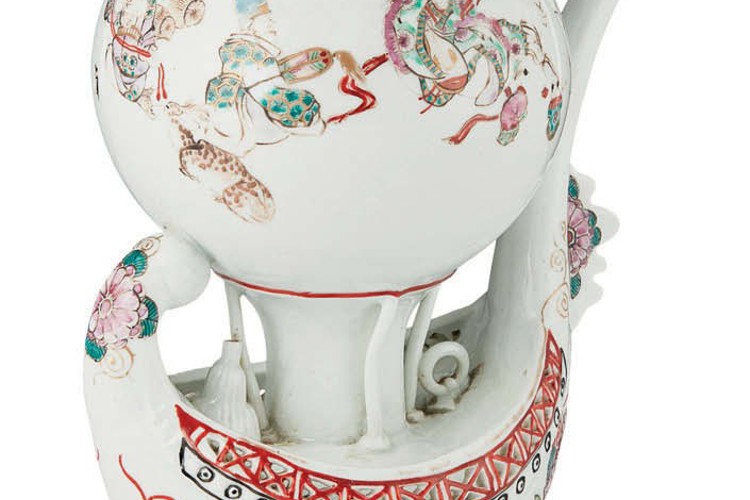
Lyon & Turnbull – November 8
Edinburgh firm Lyon & Turnbull decamps to the Hellenic Centre, W1 on November 7 for its biannual London sale of Asian works of art. This rare Meiji porcelain ewer is modelled as a hot-air balloon tethered to a gondola and painted with the Seven Lucky Gods, 9½in (24cm) high, is estimated at £250-350.
This unusual piece is most likely a Japanese adaptation of the late 18th century Dehua blanc-de-chine model of the Montgolfier balloon. A very similar Japanese ewer, however painted with a map of Japan rather than the Seven Lucky Gods, can be found in the collection of the John and Mable Ringling Museum of Art, Sarasota, Florida.
Chiswick Auctions – November 12
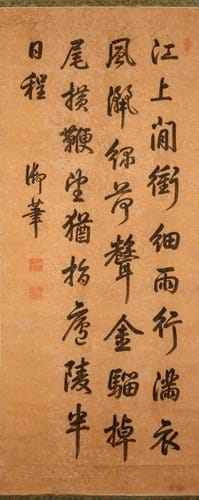
The sale of Fine Chinese Paintings at Chiswick Auctions on November 12 will include a calligraphic work by the Qianlong emperor himself. It is estimated to fetch £6000-£8000.
Born Hongli, the fourth son of the emperor Yongzheng, the Qianlong emperor (reigning 1735-96) was arguably the greatest collector and patron of the arts in more than 5000 years of Chinese history. His collection spanned Chinese, European, Japanese and Indian works of art and he was a prolific poet and calligrapher in his own right.
The sale of Fine Chinese Paintings at Chiswick Auctions on November 12 will include a calligraphic work by the emperor himself. It is estimated to fetch £6000-£8000.
This ink on paper hanging scroll of running script, measuring 5ft 2in x 21in (1.58m x 53cm), copies a poem by Wei Zhuang (836-910) which was included in the literary encyclopaedia Siku Quanshu (The Complete Library in Four Branches of Literature) commissioned by the Qianlong in 1772. It is signed Yu Bi or ‘From the Brush of His Majesty’.
“The work allows us to share a moment of artistic creation and reflection with one of the most important emperors in China’s history,” said Lazarus Halstead, head of Asian art at Chiswick Auctions.
Bonhams – November 8
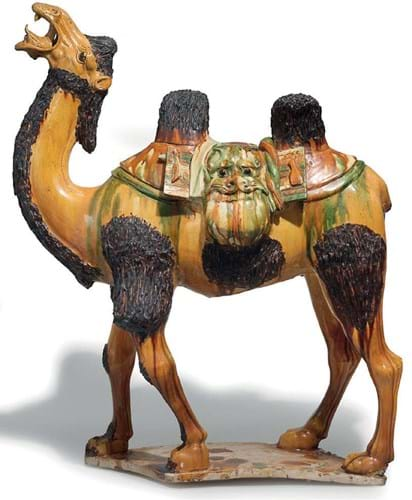
Sancai-glazed statue of a braying camel estimated at £300,000-400,000 in Bonhams’ November 8 auction.
The Tang capital Chang’an – one of the largest and most cosmopolitan cities in the world in the 9th century – became vastly wealthy thanks to its key position on the Silk Road.
Caravans of Bactrian camels, imported from Turkestan and Mongolia, were essential for conducting trade with the oasis cities of Central Asia, such as Samarkand, and those in Syria and Persia. The species was highly regarded by the Tang emperors, who established dedicated offices to oversee the imperial camel herds.
This large and realistically modelled sancai-glazed statue of a braying beast, right, standing 2ft 8in (82cm) high, was undoubtedly made to be buried with an elite member of society. It forms part of the Bonhams’ November 8 single-owner sale titled The Ollivier Collection of Early Chinese Art: A Journey Through Time. The French businessman and philanthropist, Jean-Yves Ollivier, began his collecting odyssey after visiting the National Palace Museum in Taipei in the late 1960s. He acquired this animated Tang figure from a dealer in Hong Kong in November 1991. Estimate £300,000-400,000.
The 35-lot sale will be followed by a mixed-owner sale titled Fine Chinese Art.
Sotheby’s – November 7
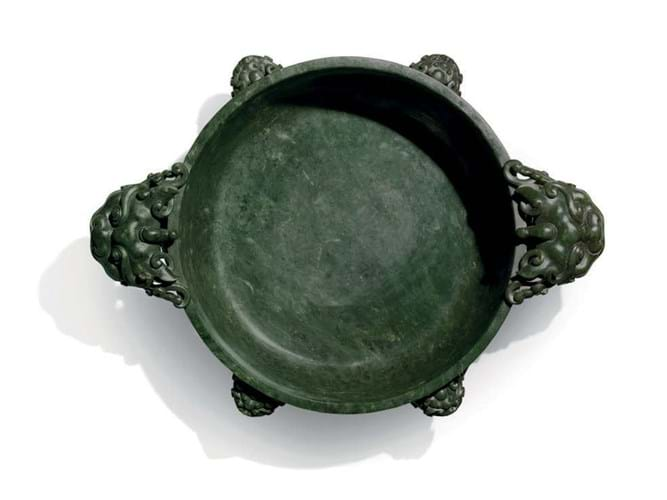
This Qianlong period spinach-green jade washer or marriage bowl is offered at Sotheby’s sale of Important Chinese Art on November 7, estimated at £600,000-800,000.
This Qianlong period spinach-green jade washer or marriage bowl, above, carved with a total of six beast-head handles and freely moving rings, measures a huge 20in (50cm) across. At Sotheby’s sale of Important Chinese Art on November 7 it is estimated at £600,000-800,000.
Once in the collection of Robert Napier, First Baron Napier of Magdala (1810-90), this monumental carving was among the 3080 works exhibited at The Royal Academy’s 1935 International Exhibition of Chinese Art. French author and jade collector Stanley Charles Nott also references it in his 1936 book Chinese Jade Throughout the Ages.
Jades of this quality, size and even colour only became possible during 1760s after the Qing army exerted control over the mines and rivers in the Khotan region. According to palace documents of the period, jade washers with freely-moving rings typically came with two, four, or six rings – the latter the most challenging to carve in an era when jade was cut by hand on an iron mill.
Roseberys – November 12
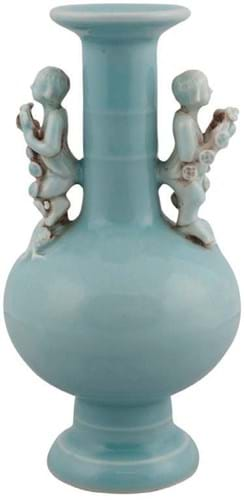
This Yongzheng mark and period ‘Liu Hai’ bottle in a claire de lune glaze carries an estimate of £10,000-15,000 at Roseberys London on November 12.
This Yongzheng mark and period ‘Liu Hai’ bottle in a claire de lune glaze carries an estimate of £10,000-15,000 at Roseberys London on November 12. The 6½in (16cm) vase includes two figures of Liu Hai, a Song dynasty minister of state who was a student of Taoist magic. He is depicted with a three-legged toad, a mythical creature he would lure from a well with a line baited with gold coins. The scene is an emblem of good fortune.
The form and colour of glaze of this vase is particularly rare. A near-identical example with a white glaze can be seen in the Palace Museum, Beijing, while a pair with a white glaze were sold by Christie’s in Hong Kong in 2013. This example comes from a private London collection, acquired in the 1960s.
Bonhams – November 6
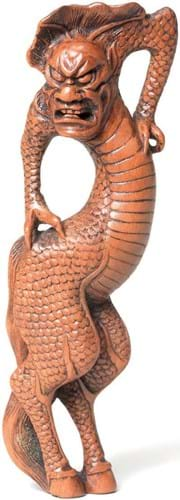
At Bonhams on November 6 the third and final part of the collection of netsuke formed by US concert pianist Julius Katchen (1926-69) and his wife Arlette is on offer, including this wood netsuke of the chimeric God of Mount Shitsugozan offered with an estimate of £50,000-60,000.
Two days before Bonhams’ Japanese sale (November 8), the third and final part of the extraordinary collection of netsuke formed by US concert pianist Julius Katchen (1926-69) and his wife Arlette is on offer. The couple made their first purchase in Kyoto while on a concert tour of Japan in 1953, later immersing themselves in the subject with the encouragement of London dealer Geoffrey Moss.
Many important purchases were made across the celebrated series of sales of the Mark T Hindson collection at Sotheby’s in the late 1960s. They included a celebrated ivory netsuke of a shaggy dog and pup by the enigmatic carver Gechu (£180,000 in the first Katchen sale in November 2016) and an ivory recumbent ox by Tomotada (£120,000 in May 2017).
Also ex-Hindson is this 6in (15cm) tall wood netsuke of the chimeric God of Mount Shitsugozan, above, offered with an estimate of £50,000-60,000 on November 6. The model is one that was made by the Osaka artist-carver Yoshimura Shuzan (1700-73) in painted wood, but this unsigned example is dated to the early 19th century.
Christie’s – November 8

This large white jade group from the Qianlong period is guided at £30,000-50,000 at Christie’s on November 8.
Born in Hong Kong into a family with a long connection in the Far East – his grandfather a missionary and translator and his father a prominent businessman – John Pearce (1918-2017) led an extraordinary life. By profession he was a broker at Hutchison International but his story includes education at Charterhouse, escape from the Sham Shui Po prisoner of war camp, an MBE for military intelligence work, a horse that finished second in the Derby and 40 years living in some splendour in a suite at the Hong Kong Mandarin Oriental hotel.
Christie’s November 8 sale includes seven hardstone carvings he purchased from the renowned Chinese art dealer TY King in the 1950s and ‘60s. This large 6½in (16.5cm) white jade group from the Qianlong period was bought two days before Christmas in 1967. The imagery of two cranes each grasping a gnarled leafy peach branch in their beaks portrays a wish for longevity. Estimate £30,000-50,000.
Christie’s – November 1-8

This mid-17th century Kutani porcelain box made in the form of a fan is estimated at £20,000-30,000 in the November 1-8 online auction at Christie’s.
Soame Jenyns (1904-76), a renowned British art historian, collector and connoisseur, was a well-known figure in the field of east Asian art. He worked at the British Museum and wrote several definitive books on Chinese and Japanese ceramics. Now out of print, some of these works change hands for over 30 times their original cost, a sign of their enduring practical value.
Christie’s will be selling his collection in November, with 24 lots included in the Fine Chinese Ceramics and Works of Art sale on November 6, alongside 138 lots in a dedicated online sale from November 1-8. Included in the online sale is this rare mid-17th century Kutani porcelain box made in the form of a fan.
It is estimated at £20,000-30,000.
Sotheby’s – November 6
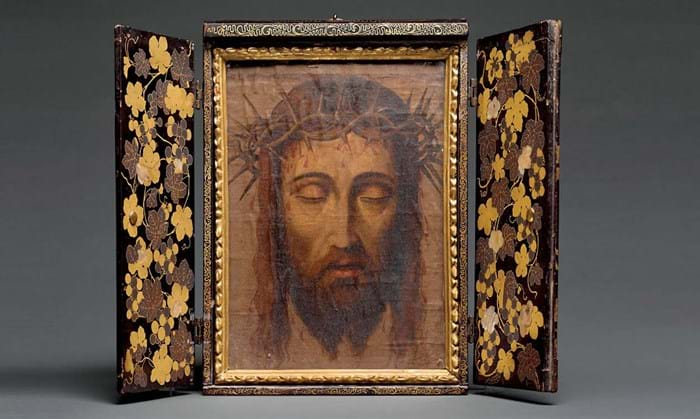
This late 16th century nanban lacquer shrine is guided at £70,000-100,000 at Sotheby’s on November 6.
As well as its sale of Important Chinese Art (November 7), Sotheby’s AAL offering includes the St George Street Sale: Asian Art on November 9, comprising several private collections of ceramics and works of art, plus a designated sale of Japanese art on November 6.
As revealed in ATG, this Japanese auction is the first sale of its type for a decade and is overseen by consultant Mark Hinton, who recently left Christie’s to work in Bond Street.
This late 16th century nanban lacquer shrine above hints at the splendours of the Momoyama during the so-called Christian century. Very few of these pieces survive as Christianity was banned by the Tokugawa Shogunate in 1620, followed by a campaign of persecution against converts.
However, the 20 or so extant devotional shrines suggest a mingling of European and Japanese Kano style: gold and brown hiramaki-e and mother-of-pearl frames housing oil paintings copying those brought to Japan by Francis Xavier and his fellow Jesuits.
This example, measuring 17 x 12in (42 x 20cm), carries an estimate of £70,000-100,000.
Sworders – November 6
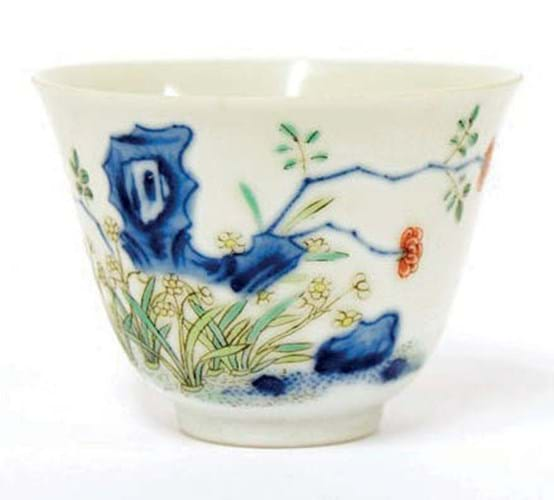
This 2½in (6cm) doucai ‘month’ cup with a Kangxi six-character mark and of the period is estimated at £5000-8000 in Sworders’ November 6 auction.
This 2½in (6cm) doucai ‘month’ cup, above, with a Kangxi six-character mark and of the period, is estimated at £5000-8000 in Sworders’ November 6 auction. It was sold as recently as 2014 as part of the collection of Roy Davids, the former head of Sotheby’s book and manuscripts department who died last year. Davids had bought it from D&M Freedman, London, in 2008.
A similar cup, part of a full set of 12, is in the Percival David Collection, with the design of this vessel – clusters of flowering narcissus and a single iron red rose blossom – representing the 11th or the 12th month.
Woolley & Wallis – November 14
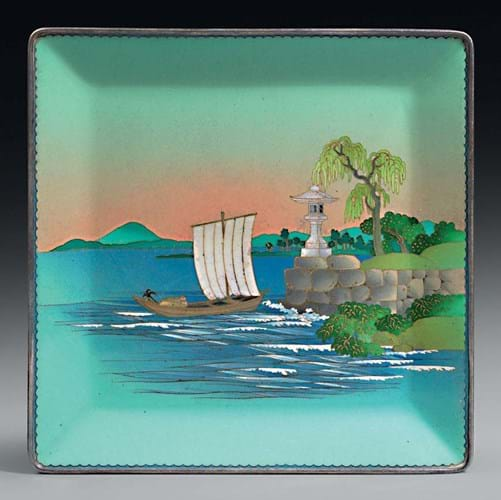
This dish, from the workshop of cloisonné artist Namikawa Yasuyuki – a relatively late design from after 1903 with landscape decoration – carries an estimate of £3000-5000 in a specialist sale of Japanese & Korean Art at Woolley & Wallis on November 14.
The market for the best Meiji material is still dominated by brand names, with collectors “particularly interested in anything different”, says Woolley & Wallis Japanese works of art specialist Alexandra Aguilar Doméracki.
This dish, above, from the workshop of cloisonné artist Namikawa Yasuyuki – a relatively late design from after 1903 with landscape decoration – carries an estimate of £3000-5000 in a specialist sale of Japanese & Korean Art in Salisbury on November 14.
Woolley & Wallis – November 13
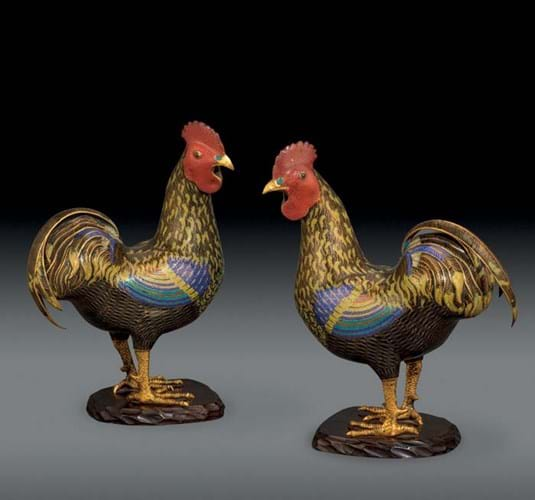
This large pair of 18th century cloisonné models of cockerels carries an estimate of £40,000-60,000 at Woolley & Wallis’ Fine Chinese Works of Art sale in Salisbury on November 13.
This large pair of 18th century cloisonné models of cockerels carries an estimate of £40,000-60,000 at Woolley & Wallis’ Fine Chinese Works of Art sale in Salisbury on November 13. The vibrantly coloured birds, each 15in (36cm) high on raised wooden stand, were formerly in the Ysenburg-Büdingen family collection and were purchased from Spink & Son in January 1954, and then by descent.














